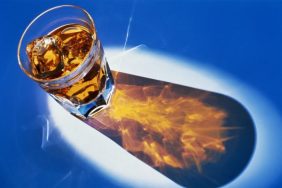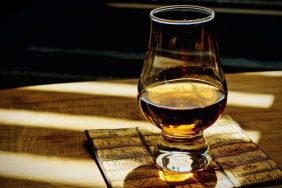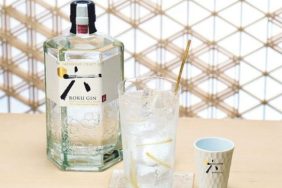“For relaxing times, make it Suntory time.” These are the words of Bill Murray’s character Bob Harris in the 2003 film, Lost In Translation. In recent years, more and more spirits drinkers have decided to forego their usual scotch and make room for Suntory time and other Japanese whiskies.
Hibiki is one of the most popular Japanese whiskies available in the US. Founded in 1923 by Shinjiro Torii, Hibiki was the first malt whisky distillery in Japan. His vision was passed on to his son Keizo Saji. Now, Shingo Torii, Shinjiro’s grandson, is the 3rd Master Blender of the House. “Suntory is a House of Master Blenders, based on the heritage and legacy of Shinjiro Torii’s vision,” says Gardner Dunn, Senior Beam Suntory Whisky Specialists – East Coast. “Suntory is still a family owned company and the vision of its founder remains untouched.”
Hibiki is a unique and truly Japanese blend that could only be born from a house of Master Blenders. “Hibiki has been praised from the world for its subtle, refined and complex flavors and aromas and is considered the paragon of Suntory’s art of blending.”
Also: Whisky Buzzwords: What is Cask Strength?
The whisky bottle doubles as a decanter that has twenty-four unique cuts. These cuts are designed to represent the twenty-four hours of a day and the twenty-four seasons of a traditional Japanese lunar calendar. “It represents Hibiki’s maturation over a long period of time throughout our four seasons.”
The name Hibiki means “resonance” in Japanese. “It speaks to the soul and emotions of the most discerning whisky lover. Hibiki resonates from nature and all the subtleties found from the twenty-four seasons of the old Japanese lunar calendar.”
The brand was first introduced into the US market in 1989. The first offering was Hibiki 17 Year Old. This was followed by Hibiki 21 Year Old in 1994, Hibiki 30 Year Old in 1997, Hibiki 12 Year Old in 2009 and Hibiki Japanese Harmony this past July. Joining the recent whisky trend, this is the first offering from Hibiki that has no age statement.
The Rise of Japanese Whisky
According to well-known whisky writer Dave Broom, Scotch made its way into Japan in 1872. The Japanese so loved the spirit, that they quickly began building their own distilleries in an attempt to make their own version. They have been producing whisky for over 100 years, but have only recently been thrust into the spotlight over the last few years.
Now, you can go into pretty much any established cocktail bar and find at least a few bottles of Yamazaki, Hakushu or Hibiki behind the bar. In his Whiskey Bible 2015, famed writer Jim Murray even ranked Yamazaki Single Malt Sherry Cask 2013 as the best whisky in the world.
Broom says: “Absolute Harmony is what best describes and differentiates Suntory Whiskies from any other Scotch and Japanese whiskies. That is not to say they are any more complex, but that the complexities are controlled within a seamless whole—and this applies across the range. The blending within single malt is another element that is deeply intriguing.”
A Japanese Whisky Visionary

Many people believe that Suntory’s founder, Shinjiro Torii, was a visionary who dreamt of creating a whisky that would reflect the best of Japanese nature and craftsmanship. “When he set out to realize his dream to build Japan’s first malt whisky distillery in Yamazaki, the outskirts of Kyoto in 1923, Shinjiro met Masataka, a young engineer fascinated by Scotch and the traditional craft of Scotch-making.” Shinjiro was advised by a Professor in Scottish Brewing to hire Masataka as his distillery manager.

Masataka argued that the best location for traditional Scotch-making would be to build the distillery in the north region of Hokkaido, which was similar to Scotland in climate and temperature. “But, Shinjiro was adamant in his wishes to build his distillery in Yamazaki,” says Dunn. Shinjiro’s vision was not to replicate the craft of Scotch-making but to create a true Japanese whisky. “Shinjiro selected the misty region of Yamazaki for the purity of its waters, and for its humid climate, required for smooth maturation.”
Shinjiro was passionate in his uncompromising pursuit to create a true Japanese whisky, fit for the delicate palate of the Japanese. “He believed in a whisky that was as subtle, refined and complex as the natural environment of Japan.” His quest to create true Japanese whiskies led to the Art of Japanese Whisky Making, and the Art of Blending, which are the qualities Suntory is most known for.
He challenged his blenders to bring to life a whisky that was subtle, refined, and yet complex at the same time. “He wanted people to choose their own way of drinking it.” Whether straight, on the rocks, or blended with water, Suntory Whiskies are built of a reputation of absolute harmony. “Torii pushed the boundaries of what a whisky could be.”
The demand for Japanese Whisky has been consistently increasing in the last few years. Suntory in particular has seen increased sales in the US due to the large amount of awards the company has received in recent years. “Suntory Whisky is the most highly awarded house of Japanese whisky and the only house of Japanese whisky ever to be awarded the Distiller of the Year Award.”
Foreseeing this continuous demand, Suntory is beginning to face limitations on the potential supply of their aged whiskies. “We are launching Hibiki Japanese Harmony to ensure that a wider audience will have accessibility to Japanese whisky through our globally acclaimed Hibiki brand.”
Hibiki Japanese Harmony

Hibiki Japanese Harmony was launched on July 2015 in the US. They believe this offering encapsulates the spirit of Harmony in whisky. “It pays tribute to the original Hibiki first launched in 1989 to commemorate the Suntory philosophy to live in Harmony with Nature and People.” Master Blender Shinji Fukuyo wanted to create a seamless blend of Hibiki offerings without needing to use an age statement.






